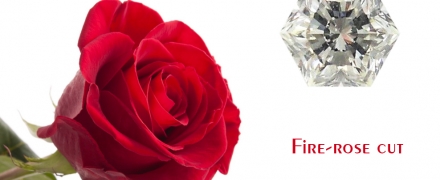open 10 am - 7 pm
laboratory is closed
Flowers and Diamonds

The first cut that bore the name of a flower was the "rose" cut, which was a diamond with one or two convex surfaces covered with facets (flat faces), which were most often triangular in shape.
At the end of the 20th century, the largest diamond mining company De Beers, together with one of the world's most famous cutters Gabriel (Gabi) Tolkowski, developed a series of flower cuts (Flower Cuts). In the mid-1990s, De Beers presented the result of its work - five new modified (fancy) diamond cuts bearing the names of the colors Dahlia, Sunflower, Fire-Rose, Marigold and Zinnia (Zinnia).
At the same time, new cuts, developed by the Siman-Tov brothers, produced the Lily Cut in the form of a four-petal flower with 77 facets, and then the Orchidea Cut with 61 facets.
In the early 2000s, the Indian company Gitanjali Groupe created its flower cuts, in collaboration with the Belgian cutter Adri Voorn. By 2005, 8 new diamond cuts were presented and patented, named after flowers and inflorescences of plants: Lotus, Ivy, Lilac, Magnolia, Tulip, Freesia , Wild Orchid. The last in the chronological order was the Calla Cut, introduced in 2005, designed by Nelson Ho and named after the Calla lily.
В геммологической практике бывают весьма увлекательные случаи с диагностикой ювелирных вставок
Но помимо редкости цвета и высокой стоимости таких камней, многие розовые камни выделяются одной замечательной особенностью – они проявляют плеохроизм, то есть в зависимости от положения осмотра камня он может иметь дополнительные оттенки – оранжевый или пурпурный.
Currently, gemstones are produced by two fundamentally different technological methods - the High Pressure - High Temperature method (“HPHT”, High-pressure & High-temperature) and the Chemical Vapor Deposition (“CVD”, Chemical vapor deposition) method. The "HPHT" method is the most tested classical synthesis method, which can be used both carbon deposition on diamond from flux melts and catalytic reactions. In "CVD" synthesis, diamond growth occurs on a seed during carbon deposition mainly from a gaseous medium at relatively low temperatures and pressures.
Jewelry and precious stones are just such a category of goods, when buying which you need to pay attention to many criteria.
Sogdianite is a rather rare mineral and more often it can be found as a collection material (moreover, in systematic collections), and it is extremely rare in jewelry.






